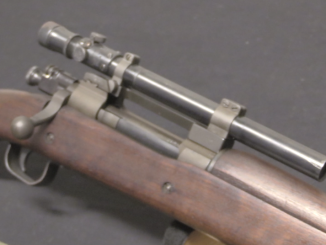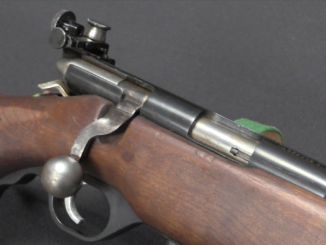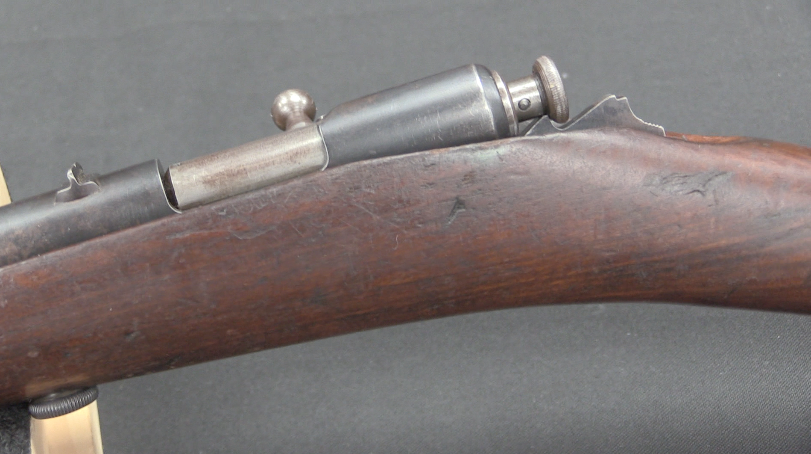I used to say that one really common and popular rifle that I really didn’t like was the H&K G3. Well, putting together this rifle for myself really changed my opinion. The roller locking system is accurate, simple, and reliable – you just have to fix all the ergonomic problems with the G3 in order to take advantage of it.
Specifically, I had this made with a reversed, left-handed charging handle (and the handle itself is from an H&K 23, for a better grip). The pistol grip frame is Magpul, the trigger was worked over by Bill Springfield, and the rifle was made with a rail welded to the receiver for easy optics mounting. Most importantly, a Spuhr stock reduced the length of pull and weight, puts the cheek rest at a proper height for optics, and dramatically improves the felt recoil.




With a big enough budget, many things can be improved. The original G3 is no fun AT All.
“(…)The original G3 is no fun AT All.”
Designers, I presume were not ordered to provide high value for that.
It must be remembered how old this design – it was developed in 1950s. As such there was certainly influence from observation from Korean War, where high number of infantrymen were involved, which would prompt to make weapon possible to produce in huge quantities.
Also it should be note that in 1950s is associated in Germany(Bonn) with Wirtschaftswunder (I do not know English name for this thing, see Konrad Adenauer for more data) and as they were transforming from “devastated” to “developed”, thus they might be unwilling to spend money without good reason.
There was definitely a ton of experience serving in the Bundeswehr then who remembered massed attacks by Ivan and competing with guys armed with Garands. They came straight from the K-98k, and wouldn’t have complained about the G-3 had you beaten them with it.
I was just thinking, Boy wouldn’t that rifle been a hit in that area (where he is shooting) back about 150 years ago!!
The Comancheros could’ve sold a ton of those.
What’s the all-up weight? It appears to buck and rear more than you’d expect from a semi auto rifle. Howsomever, I seriously dislike being kicked, so maybe I’m seeing more felt recoil than there really is. .
Point of detail. The G3 military rifle is not the HK91. It is the HK31. In HK codes of the past, 31 = select fire rifle, 7.62. 91 = US-legal semi auto, 7.62. See also HK33 (select fire rifle, 5.56), 93 (US-legal semi, 5.56), HK54 (SMG, 9mm], HK94 (semi, 9), etc. Numbers beginning with 1 indicates a light-role MG. 2 indicates a GPMG. 3 a select-fire rifle, 5 an SMG.
As you might observe last digit:
1 – 7,62×51 NATO cartridge
3 – 5,56×45 NATO cartridge
and then wonder, what with 2? It is for 7,62×39 M43 cartridge, as might be observed in HK 22, for more data see https://modernfirearms.net/en/machineguns/germany-machineguns/hk-21-i-23-eng/
When the would be dictator of a Latin American nation stole my daughter I used my G3 to kill one of her kidnappers. If Ian had been there with his lefty G3, we could have shared mags. They’d never have taken poor Jenny. Hey Sully, remember when Ian said he’d kill you last? He lied.
i have always thought the roller delayed system was stellar, best system yet.
Result of obsession with simplicity which led to complexity of different kind.
Very astute! Somehow they managed cost, capacity and strength but produced a rifle that beat up the shooter.
Note that Ian has had the unusual experience of having gotten to fire a reproduction Mauser StG45, the lower-powered ancestor of the G3. And he liked it a lot. Though I wonder if the trigger was any good. That was probably as cheap an assault rifle as could ever be fielded. The expat Mauser engineers in Spain fought for intermediate rounds for the CETME and lost out to NATO conformity. Which then meant the CETME became the overpowered G3, with more and more changes and complexity. And still didn’t solve the big jump in recoil. The roller-locked system may just have an inherent disadvantage here.
The system such as roller locked cannot produce a bigger recoil impulse then a conventional system. What you get into your shoulder and not necessarily like, is the second spike.
So be it, you are a man and you need to prove it! 🙂
“(…)was probably as cheap an assault rifle as could ever be fielded.(…)”
How it does compares cost-wise to so-called Sterling .308
https://guns.fandom.com/wiki/Sterling_.308
xor
Wimmersperg Spz
?
“(…)roller-locked system may just have an inherent disadvantage here.”
Very this system was used by HK in weapon chambered for 12,7×99 NATO cartridge, namely HK 25 machine gun (developed from HK 21), which never went into mass production.
Problem might be “pumping” design from intermediate-cartridge into full-power cartridge. Note that similarly FN FAL was not 7,62×51 mm NATO from onset, before that it used .280 cartridge
https://modernfirearms.net/en/assault-rifles/belgium-assault-rifles/fn-fal-l1a1-c1-slr-eng/
and is also sometimes claimed to have unpleasant recoil
Gas operation, can reduce felt recoil
The equal but opposite reaction to the gas piston, bolt etc, being accelerated to the rear
Is the rest of the gun being accelerated forwards.
Inevitably, the bits that were accelerated backwards will transfer their energy back through the gun and into the firer’s shoulder, but the transfer of energy has been spread out over a longer period of time.
You are not going to get that effect with a delayed blowback-hence the greater felt recoil
Everything in physical world is just a compromise right? 🙂
DOBA. Trying to get Mauser engineers with four doctorates each to make something simple must’ve been a pretty danged amusing experience in the first place. Product-improved versions probably weren’t much easier.
You had me at .308. Now that’s a rifke.
So
German designers decided to relocate to Spain
They design gun
Germany “borrows” the design and makes their gun
*time passes*
Ian shoots G3
Ian no like G3
Ian mods G3
And there was much rejoicing
“Yey”
Since the HK91 action is so violent, a consequence of designing for maximum reliability under the most adverse conditions, how much would its character change when shooting reduced charge ammunition? Would it still function pretty reliably, yet a lot more pleasant to shoot?
I wonder what the original F.A. CETME Modelo A with the original Spanish low powered 7.62mm ammo was like to shoot?
All there is to know about it, not everything that comes in is appropriate.
The system with a roller delay is configured not just for a specific ammunition, but even for a specific barrel length.
Bypassing the boring details:
G3 or SETME-B will fire cartridges from SETME-A, but there will be chimneys and other delays.
SETME-A will fire NATO ammunition, but this will break the rifle.
Correction.
Instead of SETME-A, early SETME-B for 7.62X51 SETME cartridges.
The Modelo A fired the original 7.92 version, which was similar in muzzle energy to the 7.92×33. So a lot like the StG 45 that Ian tested a reproduction of in a past video.
The proposal from one of the CETME Germans to compromise on the 7.62 NATO using a scaled-down version of his ultra low drag bullet, combined with a milder loading, might still be worth investigating today for armies that can’t or won’t give up their old GPMGs. OA length might be a problem with that bullet, though.
https://www.youtube.com/watch?v=vP4KZdLCl9g&t=2s
There is some uncertainty in this matter…
http://old.municion.org/7_92x40/7_92x40.htm
http://old.municion.org/7_92x40/7_62x40.htm
https://en.wikipedia.org/wiki/CETME_rifle#Model_A
https://en.wikipedia.org/wiki/Heckler_%26_Koch_G3#Variants
https://military.wikia.org/wiki/CETME_rifle
http://www.military-today.com/firearms/cetme.htm
Understandable with model-C, 7.62NATO.
It seems to be understandable with model-B, pref1-weakened 7.62×51 and pref2-normal 7.62×51.
Model-A, confusion…
In addition, I heard that the weakened version of the 7.62×51 cartridge was abandoned by the military… because of its weakness.
A bullet of the usual shape stuck in the air too quickly.
There is some uncertainty in this matter…
http://old.municion.org/7_92x40/7_92x40.htm
http://old.municion.org/7_92x40/7_62x40.htm
https://en.wikipedia.org/wiki/CETME_rifle#Model_A
https://en.wikipedia.org/wiki/Heckler_%26_Koch_G3#Variants
https://military.wikia.org/wiki/CETME_rifle
http://www.military-today.com/firearms/cetme.htm
Understandable with model-C, 7.62NATO.
It seems to be understandable with model-B, pref1-weakened 7.62×51 and pref2-normal 7.62×51.
Model-A, confusion…
In addition, I heard that the weakened version of the 7.62×51 cartridge was abandoned by the military… because of its weakness.
A bullet of the usual shape stuck in the air too quickly.
Obviously designed for use in the Southern Hemisphere where the Coriolis Force reverses direction